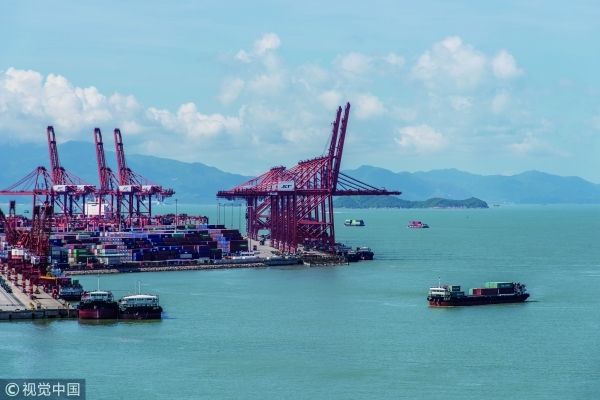Full coverage: China's reform and opening-up, 40 years on
By Tom McGregor, CCTV.com Panview commentator and copyeditor
Editor's note: 2018 marks the 40th anniversary of China's 'reform and opening up' that opened the doors for a more prosperous China that helped hundreds of millions of Chinese citizens escape poverty as the nation had enjoyed rapid economic growth and development. CCTV.com takes a closer look at Beijing's comprehensive reforms with a series of special reports focusing on various fields where tremendous changes have taken place ever since the introduction of the policy.

When the late Chinese leader Deng Xiaoping had ushered in reform and opening up for the nation, the pivotal plan highlighted a shift away from a centralized state-controlled economy and towards free market oriented one. The idea was to inspire the Chinese to work hard and take risks so as to boost China's GDP (gross domestic product) annual growth rates.
Beijing had transformed the landscape by introducing both rural and urban reforms for all Chinese to embark on a path of shared prosperity. When it came to the urbanization, industrialization and modernization of China, the focal point was launched in the City of Shenzhen, Guangdong Province, which was located on the country's southern coastline.
The Chinese government sought to spur a surge of cross-border trade and investments to attract a large inflow of FDI (foreign direct investments) for the country. Hence, Beijing designated five areas that would receive preferential treatment with permission to engage in more free market activities, which were known as Special Economic Zones (SEZs).
Shekou Industrial Zone
In 1978, Shenzhen was just a small fishing village and few could imagine that one day this city would emerge as one of the global hubs for hi-tech & science advancements, where tall skyscrapers would appear commonplace and the population would soar above ten million.
But how did a non-descript fishing village rise and become so wealthy and trend-setting? Well, it all started when Beijing set aside parts of Shenzhen's district - Shekou - and declared it a free trade and economics zone, where enterprises could open up and conduct business without little interference from the government.
Businesses were encouraged to open up new factories, while upgrading logistics to ensure goods can be shipped as exports or delivered to Chinese consumers in a more efficient manner.
The Shekou Industrial Zone (SIZ) was founded in 1979 by the China Merchants Shekou Industrial Zone Holdings Company (CMSK), a subsidiary of the state-owned China Merchants Group (CMG). The man recognized as the pioneer for China's first internationally-accessible development zone was Yuan Geng, former deputy chairman of CMG.
According to Global Times, a museum in Shekou was opened up last year to commemorate the success story of Shenzhen and to inform the public more on the background of China's reform and opening up. Visitors will see a statue of Yuan Geng to greet them. When they enter the premises they can view numerous original historical documents, photos, objects and letters on display.
Getting hi-tech facelift
The SIZ had played a remarkable role to set the stage for China to become a world leader in manufacturing and exports, but the City of Shenzhen continues to look ahead, not backwards. Hence, the southern Chinese coastal city is marching forward on Industrial 4.0 that encourages innovations above all else.
The transformation started after China was welcomed as member of the World Trade Organization (WTO) on Dec. 11, 2001. less than one year later, Xinhua had posted an editorial, dated Sept. 29, 2002 outlining the Shenzhen strategy.
Beijing called for the city to open up even further to global investors to support local efforts to build up its banking, securities, insurance, logistics, commerce and tourism sectors. Additionally, the Shenzhen Stock Exchange has risen in status where international investors can buy and sell shares of China's leading hi-tech and science companies.
The Western-media has dubbed Shenzhen as China's Silicon Valley and deservedly so. The smartphone and digital equipment manufacturer Huawei, and one of China's Internet giants Tencent, are both based there along with many more hi-tech and science firms.
Shenzhen is flourishing, because local residents continue to set their sights on the future and prior success is no longer good enough for them.
In 1979, China only accounted for 2% of the world's GDP, but as of the end of 2017 that figure stands at 15%. And let's take a closer look at the provincial figures for Guangdong. From 1978 to 2017, Guangdong's GDP had risen at an annual average growth rate - 12.6% to reach RMB 8.99 trillion (US$1.43 trillion) in total aggregate value.
When the world ponders the economic miracle of China, they can look at Shenzhen as the beacon of light for the nation's reform and opening up. And if they wish to view China's future, they can also visit Shenzhen to see what's on the horizon for the country.
(The opinions expressed here do not necessarily reflect the opinions of Panview or CCTV.com. )

Panview offers a new window of understanding the world as well as China through the views, opinions, and analysis of experts. We also welcome outside submissions, so feel free to send in your own editorials to "globalopinion@vip.cntv.cn" for consideration.
















